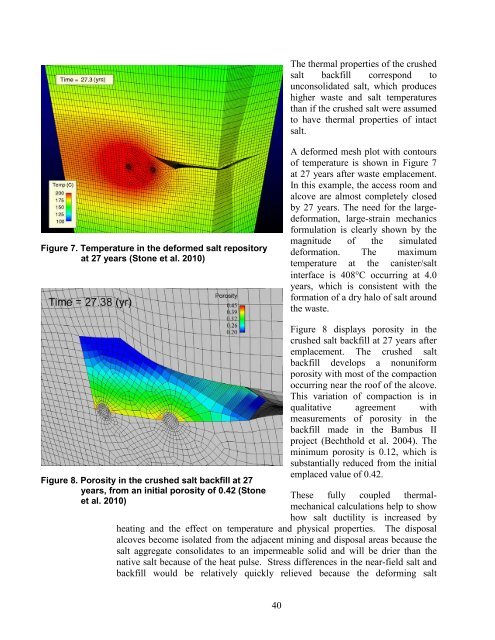Salt Disposal of Heat-Generating Nuclear Waste
Salt Disposal of Heat-Generating Nuclear Waste
Salt Disposal of Heat-Generating Nuclear Waste
You also want an ePaper? Increase the reach of your titles
YUMPU automatically turns print PDFs into web optimized ePapers that Google loves.
The thermal properties <strong>of</strong> the crushed<br />
salt backfill correspond to<br />
unconsolidated salt, which produces<br />
higher waste and salt temperatures<br />
than if the crushed salt were assumed<br />
to have thermal properties <strong>of</strong> intact<br />
salt.<br />
Figure 7. Temperature in the deformed salt repository<br />
at 27 years (Stone et al. 2010)<br />
A deformed mesh plot with contours<br />
<strong>of</strong> temperature is shown in Figure 7<br />
at 27 years after waste emplacement.<br />
In this example, the access room and<br />
alcove are almost completely closed<br />
by 27 years. The need for the largedeformation,<br />
large-strain mechanics<br />
formulation is clearly shown by the<br />
magnitude <strong>of</strong> the simulated<br />
deformation. The maximum<br />
temperature at the canister/salt<br />
interface is 408°C occurring at 4.0<br />
years, which is consistent with the<br />
formation <strong>of</strong> a dry halo <strong>of</strong> salt around<br />
the waste.<br />
Figure 8. Porosity in the crushed salt backfill at 27<br />
years, from an initial porosity <strong>of</strong> 0.42 (Stone<br />
et al. 2010)<br />
Figure 8 displays porosity in the<br />
crushed salt backfill at 27 years after<br />
emplacement. The crushed salt<br />
backfill develops a nonuniform<br />
porosity with most <strong>of</strong> the compaction<br />
occurring near the ro<strong>of</strong> <strong>of</strong> the alcove.<br />
This variation <strong>of</strong> compaction is in<br />
qualitative agreement with<br />
measurements <strong>of</strong> porosity in the<br />
backfill made in the Bambus II<br />
project (Bechthold et al. 2004). The<br />
minimum porosity is 0.12, which is<br />
substantially reduced from the initial<br />
emplaced value <strong>of</strong> 0.42.<br />
These fully coupled thermalmechanical<br />
calculations help to show<br />
how salt ductility is increased by<br />
heating and the effect on temperature and physical properties. The disposal<br />
alcoves become isolated from the adjacent mining and disposal areas because the<br />
salt aggregate consolidates to an impermeable solid and will be drier than the<br />
native salt because <strong>of</strong> the heat pulse. Stress differences in the near-field salt and<br />
backfill would be relatively quickly relieved because the deforming salt<br />
40
















